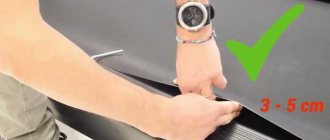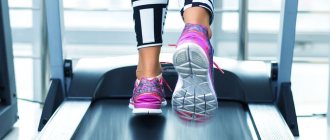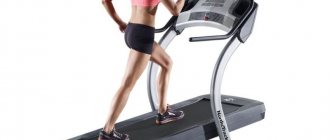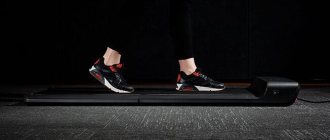The treadmill is an excellent exercise machine that is suitable for all levels of runners: from those just getting into fitness to experienced athletes preparing for serious competitions. Whether you just want to run for health without the limitations of the weather, or you are a keen runner, the track can be used to suit your needs.
However, in order for the exercise machine to be useful, improve your form and give you pleasure, you need to know and follow the rules of how to run on the treadmill. A treadmill helps simulate running outside, but it's not quite the same.
Running on a treadmill has several nuances, but understanding them is not that difficult. We will talk about this and much more in the article.
Features of running technique on a treadmill
By using proper running technique, you can not only improve your running efficiency, but also protect yourself from the injuries that plague runners. Here are a few rules that work when running on a treadmill.
Look straight ahead
Don't look down, nothing will happen under your feet, and lowering your head to follow your eyes puts stress on your neck and upper back. Bending your neck will not only affect your posture, but will also make breathing difficult. Looking at the road surface can also cause dizziness.
Don't slouch
Another mistake people make is slouching their shoulders while running. Keep them relaxed by periodically lowering and shaking your arms.
Keep your back straight
Be sure to keep your body position straight: the treadmill will pull your legs back, but you don't have to lean forward much. Otherwise, you may experience neck and back pain or lose your balance.
Photo: runnersworld.com
Breathe through both your mouth and nose
Beginning runners may read the instructions to breathe through the nose, but the nose will not be able to take in enough air for the stress of running. Moreover, there is not enough oxygen in the rooms, so breathing through the mouth is necessary to fully satisfy the body's needs.
Don't put your foot too far forward
Watch where you step as you land. Ideally, when you hit the treadmill, your foot should be directly under your body and not far in front of it. Excessive forward motion can strain muscles and tendons.
marathon and half marathon training plans and start training today!
You may have to shorten your stride and increase your running tempo to maintain this technique, but with practice it will come naturally.
Land lightly in the middle of your feet.
It is also very important not to pound your feet as hard as you can on the path. Run with light steps, touching the surface with the middle of the foot, not the toe or heel. Landing correctly will prevent many running injuries.
Do not turn your feet to the sides
Your toes should point straight ahead while running. If this is difficult, reduce the speed and incline and simply run, placing your feet on an imaginary or outlined line.
Work with your hands
Keep your arms at an angle of no more than 90 degrees and actively help yourself by moving them. But pay attention that your hands do not cross the center of your chest, because otherwise you artificially limit the amount of air that can enter your lungs.
This twisting movement, repeated for a long time, causes great stress on the muscle groups of the body. This requires more energy from you. Also, make sure your palms are open and not clenched into fists.
To summarize the technical aspects of treadmill running, we want to emphasize that every part of the body plays a role. And if one of them is in the wrong position or makes the wrong movements, it affects the others. This is where injuries and imbalances come from.
What is the effect of increasing the angle of inclination?
Angle adjustment is a popular option in both inexpensive treadmill models and the most modern versions from the world's leading brands of sports equipment. Only in mechanical and magnetic cardio trainers is it adjusted manually, and in multifunctional electric ones – using the on-board computer. The angle can be from 6 to 15 degrees.
Like changing the speed of movement, adjusting the angle of inclination of the canvas affects the level of load - going uphill increases it many times over. At the same time it helps:
- give variety to the workout (especially by turning on the “Hills” program, which simulates not only going up, but also going down by alternating changes in the position of the track);
- increase endurance - returning to your previous runs in a straight line will immediately make you feel how much more difficult it is to run at an angle;
- in addition to aerobic, include a strength element of training, which requires tension not only of the muscles, but also of the ligaments and joints of the legs.
- increase coordination – the biomechanics of lifting are quite complex and require coordination of movements;
- due to increased load, burn more calories in a given unit of time.
The higher the inclination, the greater the stress on the calf and thigh muscles, as well as on the shoulder girdle - a natural need arises to intensively help yourself with your hands.
Peculiarity! By increasing the incline angle by just 5% from the standard position, you will save an additional 100 calories.
It is strongly not recommended to use the incline during pregnancy, the elderly and beginners.
How many calories are burned when running on a treadmill?
The number of calories you burn during any physical activity is very subjective. It is impossible to give a definite answer, since calorie burning depends on body weight and intensity of work. The quantity and quality of sleep, general health and activity during the day also affect.
But there are average numbers that can tell you how many calories you will burn on the treadmill over a certain period of time.
Harvard Health Publishing published the results of a study on calorie burning, including on a treadmill. The starting points were weight, speed 8 km/h, flat surface and 30 minutes of running:
- for weight 57 kg – 240 calories
- for a weight of 70 kg – 288 calories
- for a weight of 84 kg – 336 calories.
The tracks have a built-in calorie counter, but you shouldn’t trust it if it doesn’t take into account gender, age, weight and heart rate sensor readings.
Many beginners do not run, but walk on a treadmill. What's the deal with calorie burning? The same Harvard study gives the following figures for walking on a flat surface at 5.5 km/h for 30 minutes:
- for weight 57 kg – 107 calories
- for weight 70 kg – 133 calories
- for a weight of 84 kg – 159 calories.
You can increase your energy consumption by setting the inclination of the treadmill upward. For example, a person weighing 84 kg walking on a 10% incline at a speed of about 5.5 km/h can burn about 250 calories in 30 minutes. The steeper the slope you walk and the faster your heart beats, the more calories you burn.
It's the same with running. The upward movement helps to increase the heart rate, that is, energy consumption, and therefore, hypothetically, weight loss. Running fast can be dangerous if you're just starting out, but running at a 10-15% incline won't make your legs move faster, but it will make your heart beat faster and your muscles work harder.
Non-Running Treadmill Exercise Options for Burning Fat
Simple training rules
- Exercise in the morning. It is in the morning that calories are burned most intensively.
- The time worth spending on training is 30-40 minutes.
- Drink water. The body must not be dehydrated.
- Start by jogging slowly for a few minutes. Before finishing your workout, you need to slow down your running pace and allow your body to cool down, after which it is recommended to walk for a few minutes.
- Monitor your pulse, it should be no more than 130 beats per minute.
- Breathe rhythmically.
- Listen to music, because running to your favorite songs will be much more pleasant and interesting.
Pros and cons of running on treadmills for men.
Walk into any gym and you will see that the cardio machines are mostly occupied by women of all ages. Many men forget the importance of walking and running, focusing entirely on lifting weights and increasing muscle size. A treadmill, the benefits and harms of which depend entirely on your approach to training, can come as an unexpected surprise for men: include cardio in your workouts and your results will immediately improve. Do not forget to minimize the risks, which we will discuss below, and you will strengthen not only your muscle corset, but also your health.
Pros of running on treadmills:
- The benefit of a treadmill for men, first of all, is to increase endurance. Large muscle mass is the foundation of a beautiful, strong body, but the higher your endurance, the more training time you can endure without running out of steam. Good stamina is needed in everyday life.
- The treadmill is also useful as a warm-up machine before the main workout. To avoid injury, the muscles must be thoroughly warmed up. Running or even brisk walking promotes intense blood flow to the muscles, and your body will warm up quickly.
- The sensations from running on the track and on the street are almost identical, the running motor skills and the work of the main muscles are the same, which means that the treadmill will allow you to prepare for long or high-speed running, including in competitions.
- Cardio training allows you to “dry up”: thanks to exercise on the treadmill, your muscles will become more defined, drawn, and the relief will be better visible. In addition, on the track you can fight the consequences of a sedentary lifestyle and various feasts: the belly will disappear, the thigh muscles will strengthen, and the whole figure will become more toned.
Disadvantages of running on treadmills:
- Treadmills can be harmful if you decide to start exercising intensely without being a trained runner. It is important to measure your strength and, if you have never run before, start with short distances and low speeds. Too fast a pace or a long workout can lead to injuries and other problems. Don't chase your neighbors around the gym, distribute the load wisely.
- Running can be a pain in the ass if you're not used to long periods of cardio. You will feel hard and bored, and you will hate this machine and never go near it again. Try to entertain yourself with something during class: listen to music, watch a movie - this will make it psychologically easier for you to wait until the end of the workout.
- The harm of a treadmill, which doctors talk about, is the high load on the joints and spine. The moving belt itself does not provide sufficient shock absorption, although it is more gentle on your knees and lower back than asphalt on the street. If you have joint or ligament problems, be sure to consult your doctor before starting exercise. The same applies to other diseases, especially those related to the cardiovascular and respiratory systems. The basic rule: you can exercise, but you need to approach this process thoughtfully and be sure to monitor your well-being.
Pros and cons of running on treadmills for women
Women, as a rule, come to the gym only to work out on cardio machines. The goal of many is to lose weight, become slimmer and fitter, and a treadmill is perfect for these purposes. In addition, even 15 minutes of running and 30 minutes of intense walking a day strengthens the skeletal system, helps to avoid most diseases and injuries, improves the mobility of all joints and ligaments, and helps to become more resilient, which is what every woman needs for everyday life.
Pros of running on treadmills:
- A treadmill will benefit you even if you can't or don't know how to run. A person needs a minimum of ten thousand steps a day to compensate for the effects of a sedentary lifestyle. When the weather allows, of course, it is better to walk these ten thousand steps along the paths of the park. But the remaining nine months of the year you can walk along a moving path: the effect will be approximately the same.
- The benefits of treadmills for women are the same as for men - strengthening muscles, increasing endurance. Women are, in principle, more resilient than men, which means that cardio training will be easier for you, and you will achieve results faster.
- The treadmill really helps to get rid of excess weight, while pumping up the muscles of the legs and buttocks. Long slow cardio or intense interval training - the choice is yours. By increasing the distance, speed, and incline of the treadmill, you can add variety to your activities.
- Running strengthens the cardiovascular system and helps prevent diseases associated with the heart and blood vessels. In addition, it strengthens the immune system and stress resistance, allowing you to fight even seasonal colds.
- When exercising on the treadmill, the body begins to better process incoming elements and remove toxins, which means your skin color, quality of nails and hair will improve.
- Exercises on the treadmills are universal: they are suitable for those who are heavy, pregnant women, and the elderly. The only difference will be in the intensity of the workout and its duration.
Disadvantages of running on treadmills:
- The harm caused by treadmills is based on the very mechanics of movement: a strong impact load falls on the feet, knee joints, and lower spine. To train on the track, you must wear special shoes and adhere to a certain movement technique. In order not to harm yourself and carefully monitor your running technique.
- It is important to monitor the room temperature during classes and be sure to follow the drinking regime. Long cardio leads to dehydration - you may feel dizzy, dry mouth, and weak. Don't forget to take breaks and drink water so as not to harm your body.
- A treadmill can be harmful if you have a large body mass: the stress on your joints will be too high and you may get injured. But walking is just as effective for losing weight as running – start with intense walking, and the excess weight will gradually disappear. When you feel that you can do it, start to gradually start running. And don’t forget that during exercise you can’t lean on the handrails or hold on to the handles of the machine: this changes the natural mechanics of movement.
How to avoid risks?
- Start with short workouts at low speed. Of course, you will want quick results, but you should be careful. Gradually increase the speed and distance you run on the treadmill.
- Don't forget that a treadmill can bring both benefits and harm. Consult your doctor before starting exercise. Contact a fitness trainer to establish the correct, safe movement technique.
- Do not forget that running sneakers during exercise are not a fashion statement, but a necessary attribute. You will immediately feel the difference when you start running in the right running shoes: the excessive load on your lower back will disappear, your knees will stop hurting, and it will become easier for you to maintain your running speed.
- The benefits and harms of a treadmill also depend on your psychological mood. The treadmill can become your least favorite exercise machine if you get on it every day without wanting to. Play your favorite music, listen to audio books, watch movies and TV shows on your tablet - do everything to avoid getting bored during your workout.
- Monitor your health and monitor your heart rate. Organize your workouts so that your heart rate is in the zone of 60 - 70% of the maximum: in this mode, fat burning works, and you will not get too tired and will not finish the workout earlier than planned.
How much should you run to lose weight?
Running is one of the best ways to lose weight. But in order to make progress, you need to know a few secrets and follow simple rules:
- run for 40 minutes to an hour so that your body switches to burning fat, and if you can’t run that much, alternate between running and walking;
- combine training with a balanced diet so that less energy comes in than is expended;
- run at least three times a week and do strength exercises, because muscles consume a lot of energy;
- Once you gain experience, do interval training to get your heart rate up.
Read more on the topic: Running for weight loss: how and how much you need to run to lose weight
A few words about diet
By applying the principles of a healthy and rational diet, it is much easier to cope with excess weight and maintain yourself in excellent physical shape.
It is advisable high-calorie foods high in fat and sugar from your daily diet
- pancakes;
- pies, pizza;
- all foods fried in oil;
- baked goods;
- sweet juices;
- sweet carbonated drinks
You can treat yourself to cakes only occasionally, on holidays and in moderation.
When losing weight and training on the track, you should include in your daily menu :
- Boiled chicken and fish. They are sources of easily digestible protein, which is necessary for the structure of muscle tissue;
- Fresh vegetables. They are sources of fiber, vitamins and minerals;
- Leafy greens, all types of salads. They provide the body with essential vitamins, diversify the diet, and are low in calories;
- Spicy herbs - dill, cilantro, tarragon, basil, thyme. They activate metabolism and are effective for burning fat.
What muscles are involved?
The treadmill mainly works the lower body and cardiovascular system. However, no differences from running on dirt and roads.
Main muscles involved:
- quadriceps
- hamstrings
- hip flexors
- calf muscles
- gluteal muscles.
The calves and buttocks are actively worked if the inclination of the treadmill is increased to create an imitation of an uphill movement.
Photo: rockay.com
When you run, you also engage your core muscles, which keep you balanced and upright.
The back, shoulders and arm muscles are used with less intensity. If you want to run with dumbbells to actively work your upper body, we advise you to study the article Running with dumbbells in your hands: benefits or harm.
Running shoes and clothing
For training, it is advisable to purchase special running shoes . They have shock-absorbing properties, keep the ankle in the correct position, and reduce the risk of injury due to awkward movement. The sole has good grip on the working surface of the track.
Clothing should be made from natural materials , such as cotton. You can use special branded running clothing, which is made of synthetic materials.
the 11 best running shoes for trail running here.
A treadmill will give you energy, a positive mood, help you lose weight, and strengthen your muscles. The only condition is regular exercise and a positive mood!
Treadmill Safety Rules
A treadmill is a bulky machine with moving parts, so it is very important to follow safety rules when exercising on it.
Emergency stop
For safety reasons, all treadmills are equipped with an emergency stop function. On most machines this will be a magnet that is attached to the treadmill with a thin string and it will stop when you remove the magnet.
Before you start running, try playing with the emergency stop function. This “training” will be useful: if you need to stop urgently, you will know where the magnet is and how to stop the track.
Turn on a track
Never stand on the track tape without turning it on. Turn on the simulator while standing on the side fixed parts. As soon as the tape starts moving, carefully step onto it.
Stop track
When you decide to run fast, keep in mind that stopping on a treadmill is different from stopping on the street. First you have to either take a step to the side onto the stationary part, or press the emergency button. The best thing to do is to gradually reduce the speed on the control panel.
Handrails
They are designed for you to hold on to if you lose your balance or while resting. There is no need to run, clinging to them. This will only increase unnecessary stress on your spine.
Shoes
And, of course, do not use the path without shoes. Not only is running barefoot hard on your joints, but you also risk damaging the skin on your feet.
Electric track: description, advantages and cost
The electric track moves with the help of an electric motor. It is he who sets the required force, the speed of movement of the blade and its angle of inclination, as well as various other parameters. As a rule, these models are equipped with mini-computers that display training conditions. Many of them are equipped with sensors for measuring pressure, pulse, temperature, even calories burned, so that classes are as effective as possible.
They are also distinguished by a smooth ride, as well as uniform load distribution, various built-in programs and the ability to monitor the condition of the training person. But their cost is not inferior to their convenience; the range is very large - from 12 thousand rubles to several hundred.
Types of running on a treadmill
On the treadmill you can practice:
- flat running
- hill running
- alternating running and walking
- sprint
- long intervals
- circuit training
- long run.
Hill running
A treadmill is especially useful for running on hills if you don't have hills lasting more than 5-10 minutes in your area. Slope is usually measured as a percentage.
A typical "hill" that you are likely to encounter on the street usually has a slope of 5-8%. You can use this range of numbers as a starting point for incorporating hill running into your treadmill training program.
Alternating running and walking
The treadmill is very convenient for practicing alternating running and walking, which is recommended for all beginners. There are running and walking intervals of different durations, depending on the starting level.
Example: 1 minute jogging/1 minute walking - repeat 10 times or more if you feel good, or less if you are out of breath after five repetitions.
Interval training
Jogging, sprinting, long runs - the track is perfect for all types of running that are practiced outdoors. And it is, rather, even better suited for heavy intervals, as it forces you to run at a given pace.
Read on topic: Treadmill training: exercises, advantages and disadvantages
Which route is better to choose for weight loss?
When answering the question - how to choose a treadmill, you need to consider the main 11 types of this simulator.
The most common are:
- mechanical - the simplest option: the blade moves from your effort, you yourself vary the speed of movement, but sometimes jerks are felt, so it can be difficult to maintain smooth movement;
- magnetic - a type of mechanics, but has a smoother movement of the blade;
- electric - the most modern option: the belt moves thanks to an electric motor, you can not only set the desired speed, but also create various training programs (for example, enter and run an automatic interval training algorithm).
If you want to train at home, then it might make sense to consider mechanics for weight loss: after all, such products are now a little cheaper. The folding version is a good option for home use as it takes up little space.
However, it is mainly electrics that are most common. Such tracks with computers and sensors are much more convenient for losing weight, but using all the functions is not so easy. To familiarize yourself with the main functions, read the material - how to use a treadmill. It is quite possible to purchase them as a home electrical option at an affordable cost.
Is it possible to run on a treadmill every day?
There is no set time, frequency or distance for running on a treadmill. Listen to your body and recover efficiently with massage, stretching, baths and a balanced diet.
If you're new to running, start with slow, low-mileage runs. Then, over time, you can gradually increase the distance, frequency, and duration.
For those whose main goal is to lose weight, there is no need for daily running. With long daily runs, the heart will get used to being in an excited state with a rapid pulse. This means your resting heart rate may drop below 60 beats per minute. As a result, the metabolic rate will decrease, and calories will begin to be burned very reluctantly. Instead, include strength training on the days between running sessions.
The benefits of exercise for women
This type of exercise is especially useful for women. In addition to losing excess weight and gaining a slim figure, there are other benefits of a treadmill for women. What does a girl get by working out on this simulator? It helps women:
- preserve beauty and freshness;
- get rid of cellulite;
- strengthen the muscles of the abdomen, buttocks and thighs;
- gain an elastic, trained body;
- normalize stool by accelerating metabolism;
- tighten and make the skin elastic.
Experts in Eastern subtleties claim that with the help of running, women open the chakra responsible for attractiveness. In addition, jogging is very good for hormonal changes in the body during menopause.
However, when menopause occurs, a woman should exercise caution, because high load is harmful when estrogen levels decrease. But gentle running loads, alternating with intense walking, will make it easier to endure the hardships of the menopause and keep your body in order.
How fast should a beginner run?
If you are a new runner and cannot run without breaks, you will still get many benefits from a treadmill when using it. Both light jogging with a break for walking, and walking itself while setting the incline upward are excellent options for cardio training.
Remember: you should not suffer while running, maintain comfortable breathing and the ability to talk if you are running with a partner. For most beginners, the optimal pace will be no higher than 7:00 min/km or 8.5 km/h.
It is a rare beginner who can run without stopping for 10-20 minutes. In order to gradually accustom the body to the load, we recommend walking on an inclined surface of the path for a month or more, if necessary, rather than running. Both forms of exercise raise your heart rate, which is the main ingredient in cardiovascular training, but uphill walking is less intense.
Photo: livescience.com
In addition, at the initial stage the joints will still be weak, and running can injure them. Every step you take while running places a force on your leg that is four times your body weight! Walking, even on an inclined surface, reduces the load on the joints, because there is no flight phase and the body weight is distributed on both legs.
Recommendations:
- first month: walking on an inclined surface;
- then alternating running and walking - as long as necessary;
- third month or later: easy jogging at a speed at which you can carry on a conversation and breathe calmly.
Useful: How to start running: a complete guide to running for beginners
Step length
A speed of 6 km per hour would be a good pace for a beginner or a warm-up pace for an experienced runner. However, height and stride length must be taken into account. This pace would require jogging for a shorter runner, but a taller athlete may have to “fake” jogging to run at this speed.
This speed requires a shorter, flowing style that emphasizes a stride with little knee lift, which helps advanced runners warm up before sprinting.










